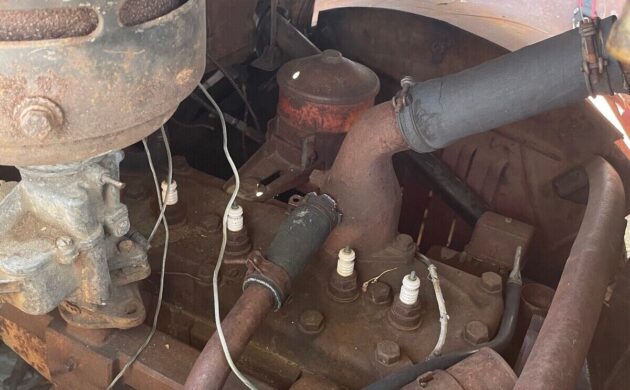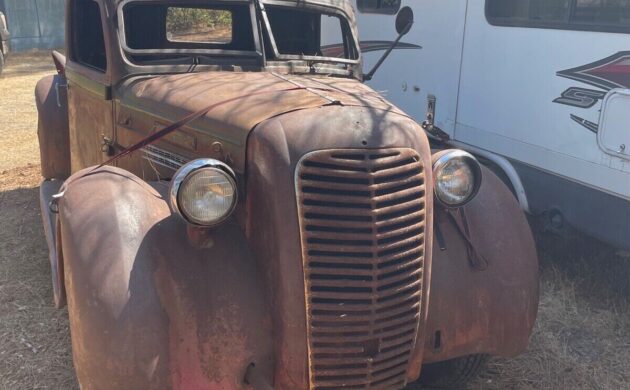Rough Gem: 1937 Diamond T 80 Standard
Diamond T was one of the most storied manufacturers ever to grace America. The company was founded in Chicago in 1905 by Charles Tilt. Its logo was drawn from his father’s shoemaking company: a diamond with a “T” in the center, implying top quality. Its first vehicles were actually automobiles, but it rapidly transitioned to commercial trucks when a customer who ran a plumbing business asked for a truck. “Old No 1” was a three-ton chain-driven monster. For several years, Diamond T was devoted to large trucks for commercial, utility, and military applications. Despite the focus on heavy-duty uses, Tilt was often heard to say “just because it’s a truck doesn’t mean it has to be ugly.” In 1936, the company introduced its first pickup, the Model 80. The three-quarter-ton Model 80 came in a Standard or Deluxe version, defined mostly by the gauge set – a couple on the Standard, lots on the Deluxe. Here on eBay is a 1937 Diamond T Model 80 Standard, for sale with bidding at just $510, reserve not met. This project truck is located in Auburn, California. This tip was provided by the ever-prolific T.J. – thanks!
The Model 80 was powered by a torquey, six-cylinder side-valve Hercules motor making about 73 bhp. The transmission was a three-speed manual. Don’t expect any help from synchro’s on this gearbox, it’s a growler! The engine bay photos in this ad aren’t too helpful but at least there’s an extra manifold in case you need it, and we’re told the drivetrain is original. Other parts come with the sale, but the ad doesn’t supply information on exactly what’s in this box. The truck does have new tires and it does roll and steer.
Ok, so it needs a little work. The gauges may be missing; we can hope they’re in that box because you can count on those to be hen’s-teeth-rare. There’s some possibility that Packard gauges will fit. This honey of an 80 apparently utilizes Packard gauges. Otherwise, there’s eBay, here, and here. For other parts, it’s not going to be easy, because Diamond T made very few 80s in its two years of production. In fact, the entire production of all models from 1911 through 1956 was only about a quarter million. Luckily, the Hercules engine is almost ubiquitous, having been used in all manner of modes of transportation.
Streamlined styling was very popular in the day, epitomized by the Burlington Zephyr. This photo shows the crank-out windows, the creased fenders, and the beautiful grille. Restoring this beauty will be a labor of love, no doubt, but the result could be spectacular. Is anyone willing to tackle it?
Auctions Ending Soon
 2002 Subaru Impreza WRXBid Now20 hours$333
2002 Subaru Impreza WRXBid Now20 hours$333
 1975 Chevrolet Corvette ConvertibleBid Now21 hours$4,000
1975 Chevrolet Corvette ConvertibleBid Now21 hours$4,000
 1964 Ford F-100 Camper CustomBid Now22 hours$2,000
1964 Ford F-100 Camper CustomBid Now22 hours$2,000
 2006 Jeep Wrangler SportBid Now2 days$11,000
2006 Jeep Wrangler SportBid Now2 days$11,000
 1974 Datsun 260ZBid Now4 days$750
1974 Datsun 260ZBid Now4 days$750





Comments
Cool truck, and nice writeup Michelle.
Terrific article, Michelle and a heart stopper for those of us that love trucks of that era. Priced a bit high IMHO-$20k more will get you this one from Hemmings…
https://thumbor-production-auction.hemmings.com/40510/img-2909.jpeg
For a DIY type this would have to be a labor of love! Worth it though..
The engine in there is a Lhead or most often called a flathead, The only side valve engine I ever knew of was a Minneapolis Moline which the valves laid on their side above the pistons and the intake and exhaust manifolds stuck out the top of the engine. The head was on the opposite side from the rocker arms. This does not look like a Minneapolis Moline engine. So this is a flathead engine not a sidevalve.
Hi Norm, well, yes and no. Technically, you are correct, flatheads are not “sidevalve” motors, but in MIchelles defense, I notice in her writing, she uses a lot of terms that might be considered “regional” or possibly passed down from an elder. With me being an old fart, flathead motors powered just about every kind of machine I came in contact with, and many times, I heard old-timers( my age now) refer to flatheads as sidevalve motors because the valves were on one side of the motor. I know, we weren’t rocket scientists, just a bunch of dirt-eatin;’ farmboys and that’s what we called them. Thanks for the info.
I’m going to contradict the difference between Flathead and Sidevalve engines. I’d be more inclined to refer to Sidevalve as more of a British term. The book, The World’s Motorcyles 1897-1963 was originally a British publication which referred to Harley Davidson and Indian as Sidevalve engines while we would tend to refer to them as Flatheads. I’ve also heard Brits refer to the Model T as a Sidevalve. The Brits do have different ways to refer to parts of an engine or car in general. ‘Big End;”Small End.’ “Gudgeon Pin” (?) Bonnet; Boot. Light, Medium and Dark wires (???). Lucas three position switch–Smoke, Smolder, Ignite (just kidding). We use the term: Ass-backwards and they use Ass-About-Face. Petrol? Tyres? It all depends on which part of this planet you’re on…
https://en.wikipedia.org/wiki/Flathead_engine
Too far gone. Much of the body and interior has to be re-made, and good luck. Mechanical parts, believe it or not, are probably still available, although, the box may have an inch of dust on it, and any rubber long deteriorated, but they are out there, price notwithstanding, of course. The “box” contains a brake master and cylinder, and some vintage lights, and Hercules motors were known to have cracked manifold problems. The only thing here, is drop the front and cab on a modern chassis, and “clown it out” from there. The original Diamond T gauges are for sure unavailable.
As a minor correction, Michelle showed the styling is from the Burlington Zephyr, but the wrong era. In the 30’s, vehicles were doing an Art Deco streamlining thing, like trains of that time.Trains, being the most advanced form of travel. The styling was copied from the Burlington Pioneer Zephyr locomotives of the 30’s. Like the Hiawatha, streamlining was all the rage, although, I don’t think it actually did much, it looked cool. It was the 8 foot drive wheels that it got it’s speed from.
https://www.flickr.com/photos/19531332@N03/4723445912
Always good to hear from you, Howard! You nailed it-regardless if they were truly aerodynamic that era had a flash of class with that styling.
Pop Cans
Seeing the thumb latch just below where the gearshift knob would be leads me to believe it is a 4 speed, the latch being there to prevent unintentional shifts into reverse. Many old trucks had that system which was superceded by the spring loaded reverse gate found on more modern vehicles. Without those provisions, depending where reverse was located relative to the forward gears (next to first or second gears were the worst,) an unpleasant surprise might await a careless driver when starting out; the vehicle following closely at a stop light might also find the situation distressing, as well.
Hi GOM, by golly, I believe you are right. The 4 speed did have a reverse lockout lever then, although, by 1949, my 201 with a 4 speed did not have one. After the war, Diamond T “cheapened” up the trucks, and the lockout probably the 1st to go. I think reverse was moved to next to 4th to prevent clashing. Diamond Ts commanded a bit more respect than your average truck, and drivers should have known darn well where reverse was,, :)
There is one of these in the auto museum in San Francisco,near the Bay.
Great story! But you can bid on 950 cars and trucks in the Nebraska auction listed on Hemmings. Plenty of early diamond T’s like this one.
Scott- thanks for the Wiki link. The illustration even helps to explain the “alternative” side-valve designation. Learn something every day. 👍🏻
I never got onto these like I took to the 201 that came out next. However, I sure wouldn’t kick this one off my driveway. For me this wouldn’t be a bad project although you would have your work cut out for you. Gauges would be hard to find at best. Actually they look far worse than they are. Needles would be a problem. I’ve done up some gauges for other makes in the past and the bezels are fairly standard as are the works inside. The needles are the challenge. The transmission on this one would be the precursor to the Warner T-9. Not a lot of difference between the two other than the Reverse access lever. Double-clutching will be the norm but it can be mastered…
What type of clutch did the 1937 model 80 have, linkage or hydraulic?